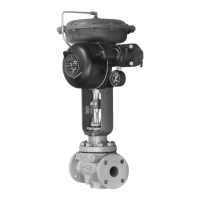Instruction Manual
D200108X012
546 Transducer
March 2015
8
If the transducer is installed in an application where explosion‐proof classification is required, perform the following steps
(prior to removal of the transducer cover) when any procedure in this section requires removal of the cover:
D Disconnect the electrical signal from the transducer.
D Remove the transducer to a non‐hazardous area.
D Perform procedures as described in this section.
D Reinstall the transducer, and ensure the cover is secured before turning on the electrical signal.
Adjustments
Adjust the filter regulator to provide the proper supply pressure to the transducer, then adjust the transducer span and
zero (see figures 5 and 6) to match the application requirements and be within specifications.
Figure 5. Zero and Span Adjustments (Cover Removed)
W5391/IL
ZERO ADJUSTMENT
SPAN ADJUSTMENT
The zero adjustment is used to set the output pressure so that it corresponds to the proper value of the input signal.
For example, if the output range is 0.2 to 1.0 bar (3 to 15 psig) and the input range is 1 to 5 mA DC and the unit is
direct‐acting, use the zero adjustment to set the output pressure at 0.2 bar (3 psig) when the input signal is 1 mA DC.
Use the span adjustment to set the output pressure span so that full output pressure change results for a full change in
the input signal. In this example, the output pressure change would be 0.8 bar (12 psi). Thus, the output pressure
should start at 3 psig and increase to 1.0 bar (15 psig) as the input signal is changed from 1 to 5 mA DC
A span adjustment will affect the zero. Therefore, follow any span adjustment with a zero adjustment. Provide a
suitable gauge to measure the pressure.
Calibration
Equipment Required
Choose a current or voltage source that is capable, without switching ranges, of driving the transducer through its
entire input range. Switching ranges on a current or voltage source will produce spikes or mid‐scale reverses in the
input signal presented to the transducer, causing errors.

